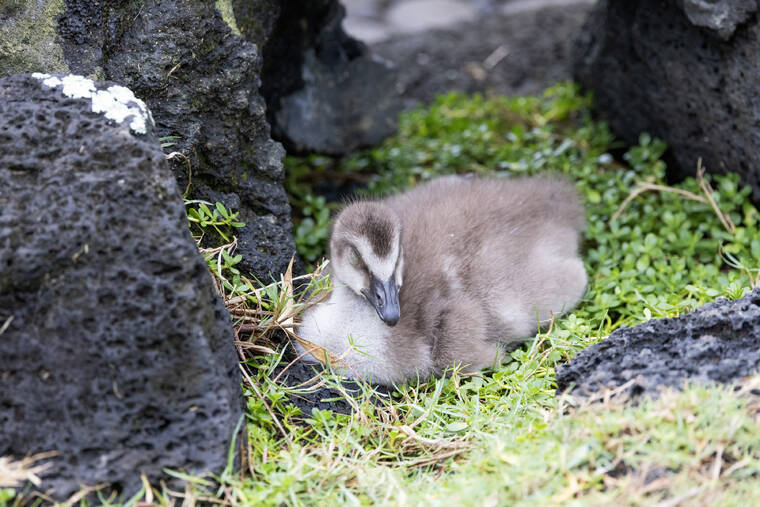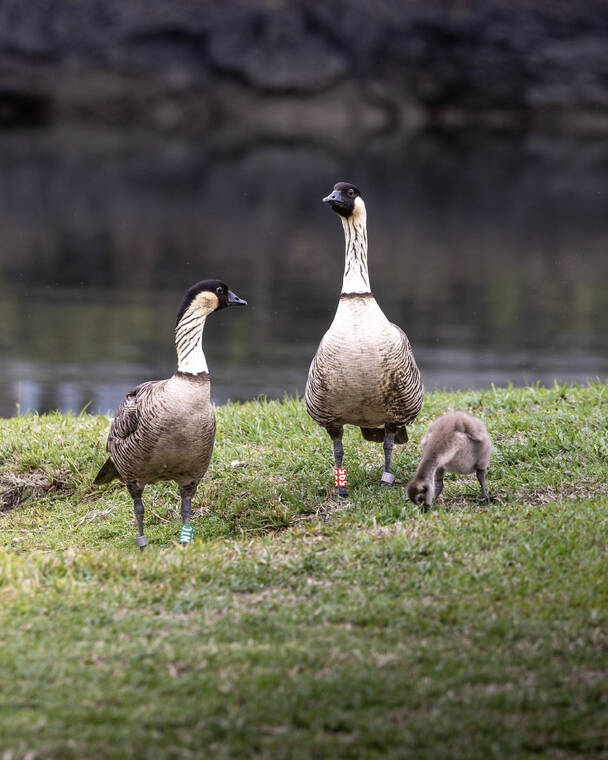The nene gosling that died last month in Lili‘uokalani Park and Gardens in Hilo likely was killed by toxoplasmosis, an infection spread in the feces of feral cats, according to the state Department of Land and Natural Resources.
Nene Research and Conservation, a nonprofit working to preserve and recover nene populations, reported that a park user heard a nene vocalizing and found a gosling deceased on March 4 in the park.
Raymond McGuire, a biologist with DLNR Division of Fish and Wildlife, or DOFAW, was able to collect the gosling and send it to the U.S. Geological Survey’s National Wildlife Health Center for a necropsy, which is an animal autopsy.
USGS determined that the diagnosis for the nene’s death was toxoplasmosis, which is caused by a parasite definitively carried by cats.
“This tragic incident highlights the problem of having feral cat colonies in areas that are known habitat for endangered or threatened species,” DLNR Chair Dawn Chang said in a press release. “Toxoplasmosis, or ‘toxo’ for short, according to the USGS, continues to be the chief cause of death for infectious diseases for nene and critically endangered Hawaiian monk seals. We must keep cats out of native wildlife habitats or we’re likely to see more deaths among Hawaii’s state bird population.”
The gosling’s mother, tagged as NTC, was the same bird that had another gosling taken from her by a woman at a Keaukaha park in March 2023.
Banyan Drive is home to at least 70 feral cats that are fed regularly by community members, according to Jordan Lerma with Nene Research and Conservation.
“We know cat lovers are animal lovers. We’re encouraging people who are feeding cats, sometimes in very large colonies, to consider the deadly consequences,” McGuire said in a DLNR press release. “We know, as animal lovers, their hearts are in the right place, but in addition to caring for wild cat populations please consider the tragic impacts imposed on two of the most iconic wildlife species in Hawaii, nene and monk seals. Open your hearts to them above non-native species like cats.”
In January, before the gosling hatched, nene were seen and photographed eating cat food in Lili‘uokalani Park.
“Feeding feral cats on county and state property is illegal if it directly harms native species. However, there needs to be more clarification and enforcement from DLNR,” Lerma said. “When we contacted DOCARE for an update on the cat feeding issue, they deferred to the DOFAW, and then DOFAW deferred again to DOCARE.
“No one is responsible, and no one is taking accountability, which needs to change.”
According to DLNR spokesman Dan Dennison, the department approaches the management of feral cat populations on a case-by-case basis, and Lili‘uokalani Park is not under DLNR jurisdiction.
Feral cats have been a detriment to conservation efforts in many areas, like Lili‘uokalani Park and Queens’ Marketplace in Waikoloa.
Last year, DOCARE ordered feral cat feeding to stop at Queens’ Marketplace as nene were eating the food alongside the large cat colony. This proved to be highly polarizing with issues arising between cat colony managers, nene organizations and the DLNR.
“In Hawaii, attempts to manage feral cats often face strong animosity, making progress seem daunting. We hope to circumvent much of that backlash and focus on solutions that can benefit both conservation efforts and feral cats,” Lerma said. “We support legislation aimed at reducing pet abandonment, which includes requiring spaying and neutering for cats older than three months and mandatory microchipping.”
The nonprofit also is advocating for laws against the abandonment of any cat on public or private property, and against the feeding of feral cats on Hawaii County property.
“We know cat feeders have big hearts and don’t want to hurt native populations, but everyone seems to be avoiding the issue due to the events at Queens,” Lerma said. “Enforcing a monetary fine for abandonment would go a long way.”
Lerma expressed support for the idea of a cat sanctuary in Hilo for abandoned cats.
“We all need to work together on this or more goslings are going to die, and more cats will be abandoned. There is a middle ground,” Lerma said.
According to Dennison, there are no plans to facilitate discussions with advocates for nene and feral cats at this time.
Nene Research and Conservation has created a petition to have the county pass legislation to reduce cat abandonment. To find the petition, visit tinyurl.com/33e5m6r9.
Email Kelsey Walling at kwalling@hawaiitribune-herald.com.




